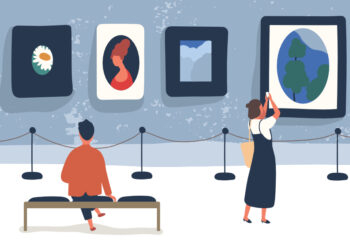As touring exhibitions are naturally connected to national and international travel, they can be perceived negatively due to concerns about their impact on the planet and about the long-term sustainability of their models. In this article, Loïc Fel, Co-founder of COAL, the Coalition for Art and Sustainable Development, provides a new perspective on the impact and role of travelling exhibitions, exploring how their potential negative impact could be mitigated and how they can actually be a catalyst for sustainable development in cultural initiatives and beyond.
An intrinsic environmental and social resource
Fundamentally, the national and international touring of exhibitions is a format that can be a resource in the process of responsible sustainable development for the cultural industry.
The most significant environmental impact of culture is the carbon footprint of audiences. Therefore, it appears much more economical from an environmental standpoint for an exhibition to come to its audiences, rather than audiences coming from afar to visit the exhibition. In that sense, the more an exhibition tours, the more visible it is, and the more it will limit its overall carbon impact: not only will visitors come from less far away, but the exhibition will also capitalise on the work already done to make the exhibition happen at the first venue – the exhibition will not be fully reinvented at each new site.
A second point that is really important to keep in mind is the social dimension of responsible sustainable development. By reaching out to wider audiences, touring allows culture to become more easily accessible. If there are only big exhibitions in big international museums, and only the people who live nearby or who have sufficient means to travel to such exhibitions are able to access them, then exclusion exists. Touring makes it possible to spread culture more widely in a powerful way.
It appears much more economical from an environmental standpoint for an exhibition to come to its audiences, rather than audiences coming from afar to visit the exhibition.

Accessibility, audience travel and transporting exhibitions
Of course, these intrinsic qualities do not exempt us from making efforts to control social and environmental impact and implement sustainable development practices in international touring. The question is, how do we prioritise the issues? The first issue remains accessibility for audiences. At each venue visited by the travelling exhibition, it is essential that good accessibility for audiences is ensured and, as visitor travel represents the core impact of an exhibition, that audiences are encouraged to use public and green transport, with a well communicated exhibition travel plan. Offering several activities with cultural and leisure partners, with the possibility of cumulative tickets, can also help. Visitors would then travel to the area to undertake several activities, which would reduce the carbon footprint per activity and also reinforce the touristic attractiveness of the area.
Then, of course, questions arise about the movement of the exhibition itself, since its impact is associated with the mass that will be moved and the means of transport used to move it, calculated in tonne-kilometre. The lighter an exhibition is, the less voluminous it is when stored for logistics and the more environmentally friendly its transportation will be. The chosen mode of transport is also a factor. Depending on the potential routes, train or boat will always be the most environmentally friendly.
Optimising routes for transportation and wider access
In the vast majority of cases, tours for exhibitions, as with concerts or live performances, are planned based on venue date opportunities, independently of other criteria. Teams end up with completely inconsistent routes from a geographical point of view, which results in a greater logistical impact than if a single coherent route, designed to minimise the length of each journey leg, had been planned. Obviously making that effort requires a lot of organisation, anticipation and effort, but rationalising tours is another very important way to optimise the environmental impact of touring. It is a whole different way of approaching touring by creating a real journey, with the possibility, once a route has been identified, to propose the exhibition to other cities on the same path.
This approach, which completely changes the way programming is envisaged, is starting to emerge. This type of initiative can generate funding opportunities and is shedding new light on touring expertise, which not only becomes very much needed, as processes become more complex, but also represents a skill set that can be capitalised on in a process of responsibility. Not only does it optimise transportation, it can also take exhibitions to places where they would never have stopped before, thus giving local audiences a unique opportunity to discover the project. Its social impact potential is therefore also strong – if the ticketing policy is also designed to enable wide access, of course.
Sourcing materials and collections
The materials used in the exhibition must then also be considered. Do we recreate the design and displays in each venue? Will this have less environmental impact than moving the display elements? There is no definitive answer to this. Depending on the location, the most sustainable resources will not be the same: in most parts of France, for instance, it might be very easy to use FSC wood from responsible forests or that can be recycled, but in other international locations this might be more complex. Each project will require its own assessment to evaluate what should be moved, and what should be produced or sourced locally. That is the core difficulty that lies at the heart of a sustainable development approach: the question has to be asked each time, and the response is often unique to each project.
Another key question is the origin of the works or objects that the curatorial team wants to present as part of the exhibition. We are used to seeing very large exhibitions, which bring together objects from many different collections across a region or the world. This adds a huge transportation and logistics component, since crates are brought to the exhibition from many different places, and actually becomes a strategic programming matter: when you want to present such an artist or artistic movement, do you select the works without taking into account any other criteria? Or do you try to favour those from the same museums or cities where they already have the key works that you have shortlisted, making it possible to organise only a small number of optimised transportations from a few locations?
The question of transportation conditions then arises, obviously with crates, which are most of the time still not a very green solution, and with the complexities implied by insurance constraints and approved carriers. We are starting to see solutions and it will be important to collectively think about the reuse of crates and greener ways to transport them.
Venue operations and management
Another key question is the use of the actual space where the exhibition will be displayed. Venues require energy and management of lighting, heating or air conditioning – all the usual building management resources. The better controlled these are, the greener the exhibition will be. The team can also make sure that the hosting venue is supplied with electricity of renewable origin – there are European certificates which can be requested. If not, an offsetting action can be taken by purchasing energy* in proportion to the energy consumed. It is quite easy to do and it enables the carbon footprint of the exhibition’s electricity consumption to be offset.
* One effective sustainable development strategy must be to follow the Avoid, Reduce, Offset (ARO) principle.
This principle involves firstly avoiding negative impacts on the environment, by avoiding the need to travel or to consume energy, by switching lights off where possible, for example.
Next, the impact of devices used must be reduced – by choosing less energy-consuming lighting, for example, but also by choosing or funding a renewable energy provider.
As a last resort, we should offset any remaining impacts by pursuing CO2 reforestation programmes or renaturation for biodiversity programmes, for instance.
As part of operations, it is also important to optimise the opening hours and venue use, so that a large number of visitors are able to visit the exhibition. The more an exhibition is seen, the less significant its overall environmental impact – which can be calculated in relation to the number of visitors – will be. This is interesting for the exhibition’s economic model as well as for its environmental impact.
Cultural exchange and engagement fostered through travelling exhibitions add an extremely interesting dimension of peace and cultural diplomacy.
A laboratory and a diplomatic resource
Touring also has a political dimension. Culture is very visible and has the potential to be an example arena to illustrate a responsible approach. Culture can be a trendsetter, and all the means developed in the cultural realm for sustainable development practice – logistics, production, management and operation – can be transposed to other industries, such as events, commerce, etc. As such, culture can also serve as a ‘laboratory’ and as a resource to promote responsible practices, which can benefit other sectors. This way, the benefits of the efforts carried out in the cultural world are further strengthened by indirect positive impact.
Beyond this, cultural exchange and engagement fostered through travelling exhibitions add an extremely interesting dimension of peace and cultural diplomacy. Cultural matters are often used as a diplomatic tool. The same question arises as the one often asked about aviation, where at one point, we wonder if we should drastically stop international lines which pollute so much, and everyone stays home. But in reality, if we did this, we would lose the crucial dimension of human exchanges and continuous encounters with others that civil world aviation makes possible. We realise that when there are no more such fluid exchanges between countries, this can lead to animosity and misunderstanding. And this is well conveyed by the fact that each time a new airline opens, it is seen as a symbol of pacification, as we recreate exchange and inter-influence. Touring exhibitions can also be a catalyst for the discovery of the culture of others; they can participate in this ‘mission of pacification’ because we are not afraid of the people and cultures we get to know or are familiar with.




